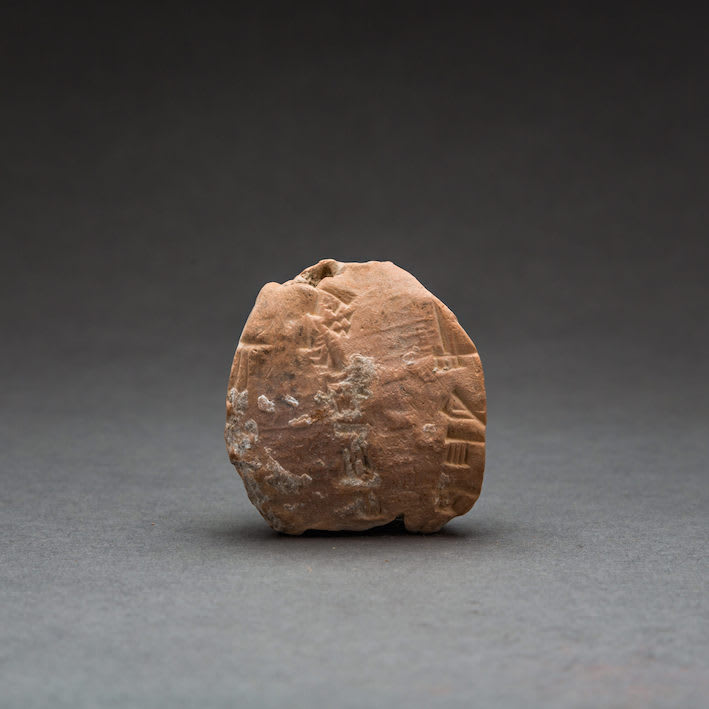Sumerian Cuneiform Bulla, 2038 BCE
Terracotta
1.65 x 2 x 1.85
LSO.33
The Sumerian civilization was an extremely advanced and complex society situated in modern day Iraq. Lasting for some four thousand years, the Sumerians were among the first cultures to develop...
The Sumerian civilization was an extremely advanced and complex society situated in modern day Iraq. Lasting for some four thousand years, the Sumerians were among the first cultures to develop most of what we now take for granted, from complex economies to advanced record keeping, literature, international trade and recorded mythologies. Thanks to the Sumerian habit of recording everything on clay tablets using cuneiform – one of the first complex writing systems – we can infer a great deal about their society. We know that Sumer was characterized by various city-states, running in competition with one another for wealth and conquest, while sharing similar characteristics and material goods. They used slave labor, based around large temples and palaces, and were keen to form alliances and thus push out the boundaries of their nation into Central Asia and Turkey. Their trade networks were extensive, and colonies of Sumerian peoples have been identified all across the region. Rule was by kingship; rulers varied considerable in their methods although extreme cruelty and martial law (such as that exercised under Eannatum of Lagash) was the exception rather than the rule. Temples were the mainstay of local economies. It was here that produce was brought as tax, legal proceedings carried out and deals were struck. Records of this period are almost exclusively written by scribes who lived within the temple walls and worked under the auspices of the administrators, who were themselves under the authority of the priests.
This is three-sided and hollow where originally rope or cord with knots was enclosed within it. The bulla was to protect the package or sack from interference.
Thus the sides are covered with impressions of the scribe’s cylinder seal and with his name and the date: Month Shunigal, year: the high priestess of Nanna of Karzida was installe This is the ninth year of Amar-Sin, third king of the Third Dynasty of Ur, c. 2038 BC. The seal shows a standing figure with bare head and long robe raising one hand to greet a seated deity. A three-line inscription names the seal owner, then gives his title and his father’s name, but all three lines are not sufficiently clearly preserved to be read in full. What the package contained may have been stated on the bulla, but if so it is now covered with hard incrustation and cannot be read.
Such bullae were normally broken when the package was opened, so this is a rare item, at large.
This is three-sided and hollow where originally rope or cord with knots was enclosed within it. The bulla was to protect the package or sack from interference.
Thus the sides are covered with impressions of the scribe’s cylinder seal and with his name and the date: Month Shunigal, year: the high priestess of Nanna of Karzida was installe This is the ninth year of Amar-Sin, third king of the Third Dynasty of Ur, c. 2038 BC. The seal shows a standing figure with bare head and long robe raising one hand to greet a seated deity. A three-line inscription names the seal owner, then gives his title and his father’s name, but all three lines are not sufficiently clearly preserved to be read in full. What the package contained may have been stated on the bulla, but if so it is now covered with hard incrustation and cannot be read.
Such bullae were normally broken when the package was opened, so this is a rare item, at large.
